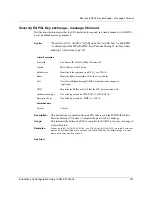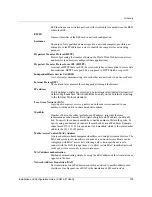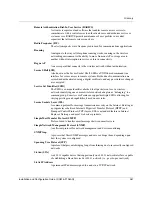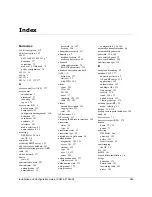
Glossary
278
Installation and Configuration Guide, (CQW-AP108AG)
Bridge
A connection between two (or more) LANs using the same protocol. Virtual
bridges are used as a means of defining layer 2 domains for broadcast messages.
Each virtual bridge uniquely defines a virtual local area network (VLAN).
Class of Service (COS)
A method of specifying and grouping applications into various QoS groups or
categories.
Differentiated Services Code Point (DSCP)
A system of assigning Quality of Service “Class of Service” tags.
Domain Name Service (DNS)
A standard methodology for converting alphanumeric Internet domain names to IP
addresses.
Dynamic Host Configuration Protocol (DHCP)
A communications protocol enabling IP address assignments to be managed both
dynamically and centrally. With DHCP enabled on a node (a system, device,
network card, or Access Point), when it boots or is connected to a network, an
address is automatically assigned. Each assigned address is considered to be
“leased” to a specific node; when the lease expires, a new IP can be requested and/
or automatically reassigned. Without DHCP, IP addresses would need to be
entered manually for each and every device on the network.
Dynamic Frequency Selection (DFS)
A method for selecting the least
intrusive and noisy available frequency for
operation, part of the 802.11 specification.
Dynamic IP Address
A TCP/IP network address assigned temporarily (or dynamically) by a central
server, also known as a DHCP server. A node set to accept dynamic IPs is said to
be a “DHCP client.”
Extensible Authentication Protocol (EAP)
Standard that specifies the method of communication between an authentication
server and the client, or supplicant, requesting access to the network. EAP supports
a variety of authentication methods.
Extensible Authentication Protocol Over LAN (EAPOL)
Protocol used for 802.1x authentication.
EAP-TLS
EAP using Transport Layer Security. EAP-based authentication method based on
X.509 certificates, which provides mutual, secure authentication. Certificates must
be maintained in the authentication server and supplicant.
EAP-PEAP
Protected EAP-based authentication method based on X.509 certificates. Uses a
two-phase approach in which the server is first authenticated to the supplicant.
This establishes a secure channel over which the supplicant can be authenticated to
the server.
Extended Service Set (ESS)
A set of multiple connected BSSs. From the perspective of network clients, the
Summary of Contents for CQW-AP108AG
Page 2: ......
Page 13: ...Preface xiii Installation and Configuration Guide CQW AP108AG ...
Page 67: ...3 Using the Configuration Interfaces 54 Installation and Configuration Guide CQW AP108AG ...
Page 113: ...4 Configuring Radio Settings 100 Installation and Configuration Guide CQW AP108AG ...
Page 141: ...5 Configuring Networking Settings 128 Installation and Configuration Guide CQW AP108AG ...
Page 149: ...6 Configuring a Wireless Backhaul 136 Installation and Configuration Guide CQW AP108AG ...
Page 167: ...7 Managing Security 154 Installation and Configuration Guide CQW AP108AG ...
Page 177: ...8 Configuring Guest Access 164 Installation and Configuration Guide CQW AP108AG ...
Page 223: ...9 Managing the Network 210 Installation and Configuration Guide CQW AP108AG ...
Page 241: ...10 Maintaining the Access Point 228 Installation and Configuration Guide CQW AP108AG ...
Page 245: ...A Using the Command Line Interface 232 Installation and Configuration Guide CQW AP108AG ...
Page 247: ...B Regulatory and License Information 234 Installation and Configuration Guide CQW AP108AG ...
Page 289: ...C Alarms 276 Installation and Configuration Guide CQW AP108AG ...











































